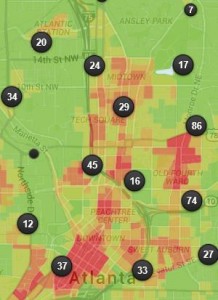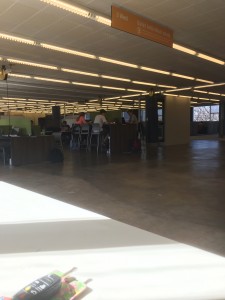Just the other night, as my friend Carly made her way from our dorm on Edgewood Ave to her early morning class in Classroom South, she found herself stepping from what she believed to be the side walk onto the street to quickly find herself stepping on to a live human who happened to be asleep in the gutter of the street. She exclaimed to me, “I don’t know who was more horrified, me or the homeless man!” As a student at Georgia State University, I have encountered many homeless people throughout my first year. I can recall a night in which I found myself being “escorted home” from a late night studying by a young homeless man who wanted someone to vent to. While this should have been seen as a dangerous situation for a young woman like myself, there is an outstanding number of homeless men and women in and around the Georgia State University Campus, so much so that the presence of these homeless citizens have become such a normality for the students of Georgia State. Although both residing in urban environments, the Georgia Institute of Technology and Georgia State University have no comparison when it comes down to the number of homeless people residing on their campuses. At GSU, It is as if the homeless are too students of the university. The question is why has this become so typical for students of Georgia State to encounter a homeless man, while the students of Georgia Tech do no face the same daily interaction?
Georgia State University is located in the heart of down town Atlanta. Due to its location being surrounded by public transportation stations, parks, and nightlife, Georgia State is a heavily populated area with people traveling in and out of its campus. Georgia State’s campus is considered to be “a campus without boundaries,” according to the Georgia State College of Law webpage. This “campus without boundaries is otherwise known as an open campus. Classrooms are spread out across the city, while offices and businesses fill the gaps between the university’s buildings. This attracts a heavy flow of business men and women as well as students navigating the streets of GSU’s campus. The abundance of people passing through this area during the day provides ample opportunity for a homeless man or woman to find a meal source for the day and other useful resources. Many times I will see a homeless person discovering a half finished burrito in the trash, or be handed leftovers from the nearby restaurant as well as loose change by anyone walking by. Although still not invisible, the hustle and bustle of this grand population often distracts from the presence of these homeless people. This allows them to live in peace with little to no conflict with the surrounding population.
Just between Aderhold Learning center and 25 park place, a classroom building and student advisement office, sits Woodruff Park. Woodruff Park is the day time home to many of downtown’s homeless regulars. Due to the numerous chess board tables and pieces located on the pavilion patio, Woodruff Park attracts many homeless people to come socialize and entertain themselves with games of chess. The location is perfect for a homeless person to spend their entire day. Just one block over is Broad Street, which is home to a large variety of restaurants and fast food, as well as convenience stores, a pawn shop, and a few small businesses. Within the park there is a public toilet located just a few yards away from the patio in which these men and women are found socializing. Massive numbers of students pass through the park each day to travel to and from Aderhold Learning center with food and money to spare.
Georgia State University is located just a block away from the historic Under Ground Atlanta Center. Under Ground, formally a railroad station during the late 19th century on into the 20th then abandoned until the late 20th century, according to underground Atlanta’s history page, is now a struggling collection of stores and small businesses. The few times that I have been through underground Atlanta, I have been astonished by the number of open drug deals, fights, and arrests that’s I witnessed in the short period of time spent. The easy access to drugs in this location attracts a portion of the homeless population. According to Alcoholrehab.com, “It is believed that about 38% of homeless people abuse alcohol while 26% regularly use other drugs.” Keeping this statistic in mind, Underground Atlanta’s apparent black market drug hub is a huge attraction for the affected percentage of Atlanta’s homeless. Not only is Underground Atlanta a source for drugs, the shopping center is home to many struggling small businesses. Because of hardships and struggle in remaining open, many of the small businesses within Under Ground are found to have more affordable services. These affordable prices also attract homeless people to the area to receive desired services.
There are three MARTA transit stations located in and around Georgia State University’s campus, Five Points, Georgia State, and Peachtree Center stations. MARTA is well known for having copious amounts of homeless people occupying its rail cars. Anyone can pay a price of $2.00 to enter the MARTA station and travel on the air conditioned train for however long they wish. So, during times of extreme weather, the MARTA rail line becomes a comfortable shelter for these individuals. Five Points MARTA station, which connects all of the major rail lines at one station, is located just on the border of Georgia State University. This center for public transit brings not only students to Georgia State, but people from all over the greater Atlanta region. This includes high crime communities like West End, Oakland City, Kensington, and College Park. With all of the opportunities and resources down town Atlanta has to offer for the homeless through the parks, shelters, and food banks, affected men and women from all over the greater Atlanta neighborhoods are drawn to this particular stop.
Georgia Tech is located in Mid Town Atlanta, just north of Georgia State University. This Geographical difference in campus could quickly be assumed to be the difference between the two campus’s censuses of homeless; however, Georgia Tech is home to Techwood Drive. “Completed in 1936, Atlanta’s Techwood Homes was the first public housing project in the nation. But in the years before the 1996 Atlanta Olympics, the community had become known for its poverty, gang violence and drug trafficking problems,” according to Kathy Lohr, on NPR’s morning edition. This community has grown over the years and has become a hub of drug trafficking, poverty, and homelessness. Still, Techwood and all, Georgia Tech’s campus appears to be homeless free. When looking at a crime map of Atlanta, It is evident that the Georgia Tech Campus’s border isolates its campus from the majority of the crime that Mid Town is home to. The built environment of Georgia Institute of Technology is the cause of this shift in crime rates.

Crime map of Atlanta Georgia. You can see Gerogia state is covered in red while Georgia Tech is completely green.
Georgia Tech, unlike Georgia State, is a closed campus. Once you step foot onto the campus, you will find that every building is dedicated to specifically Georgia tech’s students and staff. While it is a public university and is not closed off to the public population, there is no reason, other than panhandling, for a homeless man or woman to wonder on to the Georgia Tech campus. In addition to this, Georgia Tech’s overall style and structure would provide an obvious contrast between the environment and an obviously homeless individual. Typically you find homeless men and women in locations in which they can easily blend in to their surroundings. Georgia tech’s campus is well kept, clean, and bright, unlike most urban streets. Therefore, not only would a homeless man or woman unable to find a purpose in exploring the streets and paths through Georgia Institute of Technology, but they would also have a hard time blending into the environment.
One thing that both campuses have in common is the lack of homeless people inhabiting the university owned interior spaces within their campus. In order to access the university’s major buildings, you must first sign in or swipe in. This can be observed in both Georgia State’s library and Georgia Tech’s Library. The interior built environment for these Universities are so much so catered to the needs of the students and staff only, a homeless person would find no purpose in roaming around any of these buildings.
Homeless people are found more on Georgia State’s campus than on other urban campuses like Georgia Tech due to its open campus, nearby MARTA stations, historic background, and public resources. While there are no practical solutions to remove the number of homeless people from Georgia State University specifically, by providing new places to accommodate the needs of greater Atlanta’s homeless, these men and women would be less drawn to the campus for its resources. There are currently shelters scattered around Atlanta, but if provided more long term assistance that offered things like an outdoor setting to entertain themselves, small shopping center where they can find affordable products and services, and necessary food to survive, all similar to the environment GSU has produced, Atlanta’s homeless might migrate from the campus setting into this new solution setting.
“Homeless Services – Initiative for Affordable Housing.” Accessed April 29, 2016. http://www.affordablehousingatl.org/homeless-services.html.
“Underground Atlanta.” Wikipedia, the Free Encyclopedia, April 19, 2016. https://en.wikipedia.org/w/index.php?title=Underground_Atlanta&oldid=716058114.
“ICP_Georgia_Brief.pdf.” Accessed April 29, 2016. http://icphusa.org/PDF/reports/ICP_Georgia_Brief.pdf?Submit1=Free+Download.
“Census: 6,664 Homeless People Counted in Atlanta, Fulton, DeKalb | Atlanta News & Opinion Blog | Fresh Loaf | Creative Loafing Atlanta.” Accessed April 29, 2016. http://clatl.com/freshloaf/archives/2013/08/01/report-6664-homeless-people-in-atlanta-fulton-dekalb.
Lohr, Kathy. “Writer Has A Down-Home Feel For Atlanta’s Dark Side.” NPR.org. Accessed April 29, 2016. http://www.npr.org/2012/07/30/157232682/writer-has-a-down-home-feel-for-atlantas-dark-side.
“28266c4e0ae78d652422b9f14c9e8ee7.jpg (JPEG Image, 467 × 350 Pixels).” Accessed April 29, 2016. http://cdn2-b.examiner.com/sites/default/files/styles/image_content_width/hash/28/26/28266c4e0ae78d652422b9f14c9e8ee7.jpg?itok=vj-CqSnr.
“MARTA Station Map | MARTA Guide.” Accessed April 29, 2016. https://martaguide.com/rail-station-map/.
“Georgia State Law Admissions.” Accessed April 29, 2016. http://law.gsu.edu/admissions/.





